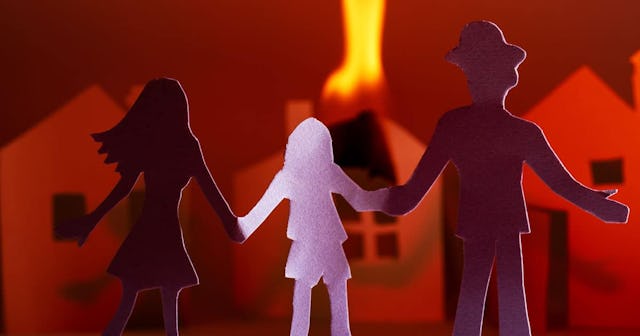I Didn't Realize How Important A Fire Safety Plan Is Until We Needed It

Thank God we had a fire safety plan, because I didn’t mean to set the house on fire. I mean, you never really do. I was just trying to make some chicken nuggets for my kids. Unbeknownst to me, but knownst to my husband, he had left a pizza box in the oven from the night before (who the hell does that?!). I hadn’t checked the oven before I hit preheat, because who assumes their husband left a cardboard pizza box in the goddamn oven, amiright?! I was working when my then-nine-year-old said, “Mama? I smell smoke.”
I looked at the oven. Smoke poured from it. Oh, fuck. I opened it. Double fuck. Flames poured from it. I grabbed the fire extinguisher we keep in our kitchen, glanced at the directions, pulled the plug, and felt like Ray Tanner from Ghostbusters when I aimed that bastard and pulled the trigger. Fluff covered my kitchen like the remains of the Stay-Puft Marshmallow Man. The fire went out, though. It took two solid days of cleanup. But I saved the house. Thank God for a fire safety plan.
Imgorthand/Getty
We have fire safety plans that meet the same standards demanded by social services: wireless, interconnected smoke alarms, one in every bedroom, the kitchen, and the living room. We have mapped-out fire safety plans, and the kids know where to go in case of an emergency. They can fit out of their bedroom windows, access them, and know how to open them. We have a designated outdoor meeting place in case of a fire. They know basic fire safety rules: stop drop and roll; never play with matches unless mama and daddy are around; turn the stove off.
Do We Really Need Fire Safety Plans?
This probably seems like overkill. I mean, fire safety plans? For real? Then look at the statistics. According to the National Fire Protection Association, in 2018, fire departments were called out to somewhere around 1,318,500 fires. 2,720 “civilians” (i.e., non-firefighters or first responders) were killed in house fires. To break it down: every three hours and thirteen minutes, someone in the United States dies in a house fire. About 11,200 people were injured that same year in house fires, or one every 41 minutes. The Red Cross says that seven people die in house fires every day — and that most of them are children or the elderly.
That’s a lot of people. You need a fire safety plan.
Moreover, according to the US Fire Association, three-fifths of all deaths in house fires occur in homes without working smoke detectors. My smoke detectors are wireless and interconnected: if one of them detects smoke, all of them go off. You cut your risk of dying in a house fire in half if you have working smoke detectors. And because half of all fire deaths happen between 11 p.m. and 7 a.m., you have to have smoke detectors in every single bedroom. Moreover, the Red Cross says that if a fire starts, you may have only two minutes to escape.
How to Plan for the Worst
sturti/Getty
1. Make sure you have working smoke detectors.
Test them every month, says the US Fire Association, by pressing them and making sure they beep. Replace them if they don’t. In any case, they should be replaced every ten years — and you’ll know the manufacture date, because every single smoke detector has a label on the back.
2. Keep a fire extinguisher in the kitchen.
The National Fire Protection Association says that “unattended cooking” is the most common cause of house fires (and caught my dorm on fire when I was in college). Because of that, Fireline says the most essential place to keep an extinguisher is in the kitchen. You should also keep one in the laundry room, says Fireline, as dryers often cause fires (this also happened to us — luckily the dryer only threw off sparks and we were able to unplug and hurry it out of the house), and near electrical panels, fireplaces, and furnaces.
3. Make sure you have a fire escape plan.
The Red Cross says to practice it at least twice a year (yeah, we should get on that). Everyone should know at least two ways out of the house. Don’t go back in to rescue people or pets. Because smoke can be dangerous, you should stay low to the ground, and an outdoor meeting place is essential. That way you can count heads and make sure everyone got out safely.
The National Fire Prevention Association also recommends residential sprinklers (we don’t have those), and making sure that appliances and the like are safer for children: lighters, for example, should be more child-proof. Put up your lighters and matches. Teach your kids basic fire safety rules.
My kids know about fire. We’ve taught them, from age five, how to use matches and lighters — and we’ve also shown them how to use them safely. This took away the curiosity aspect of what fire could do. We also keep those things stored in a place they can’t reach, and they’re only allowed to use them under our supervision.
Yeah, you think a house fire would never happen to you. I understand. I never thought a fire would happen to us, either. But thank God we had a fire extinguisher handy. (In retrospect, Fireline recommends that in the case of oven fires like mine, you should simply shut the oven door and wait for it to burn itself out). Make a fire safety plan. Practice it.
You never know.
This article was originally published on